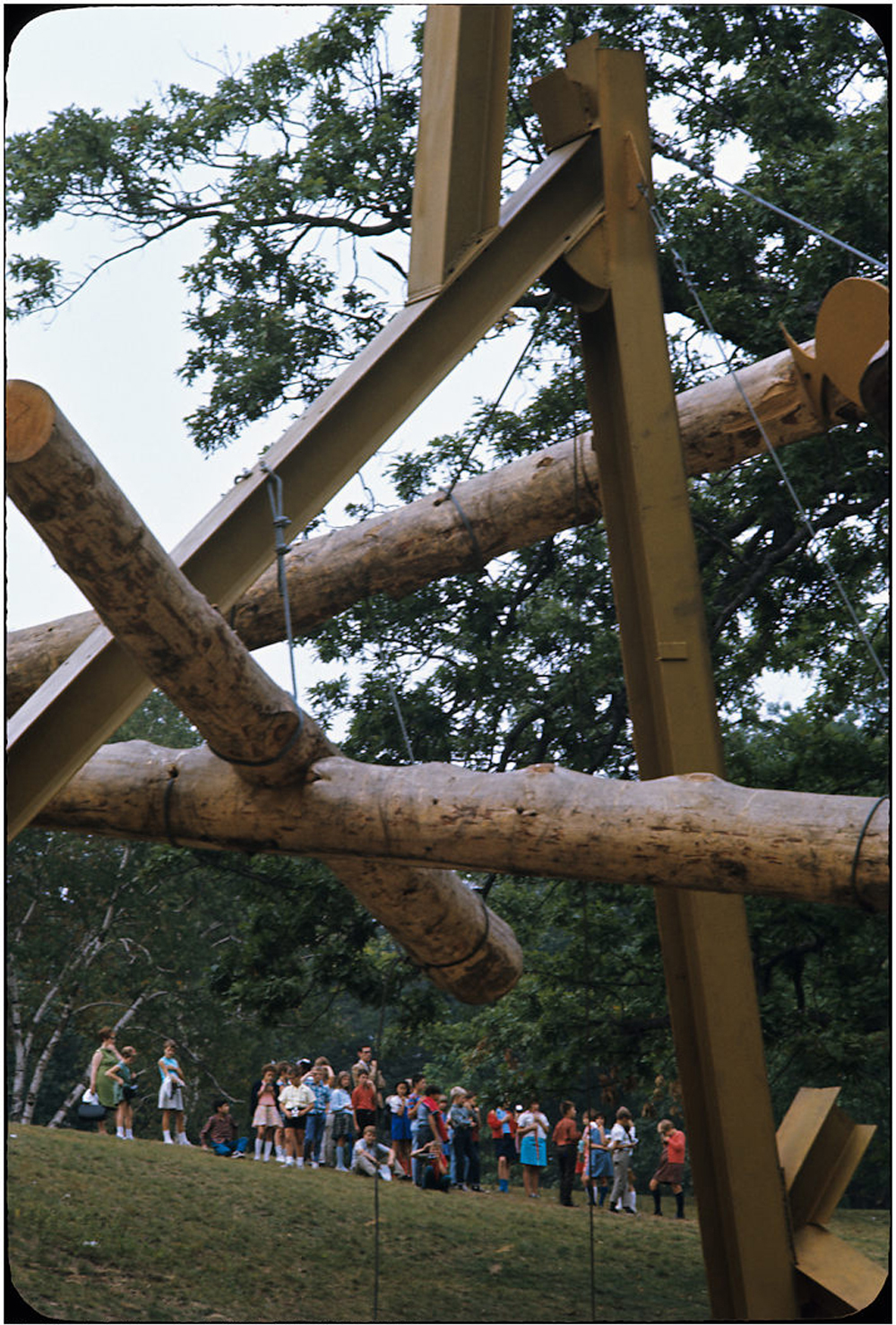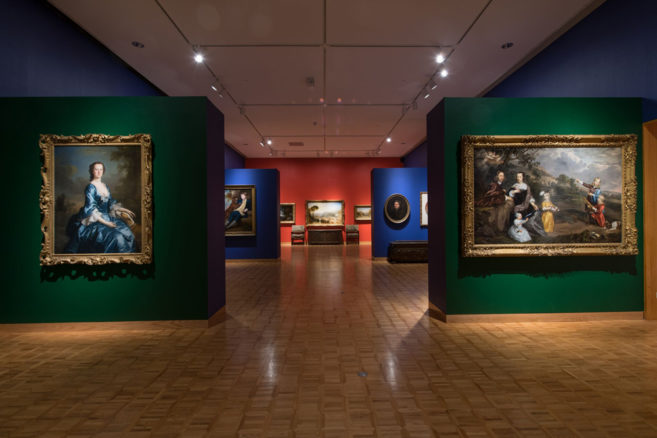When a suffragette slashes a Velazquez Venus, or an army pillages a museum, it’s dramatic. But art can be destroyed to different degrees, and for different reasons; destruction can be completely—sometimes counterintuitively—dispassionate. Audiences animate artworks, infrastructure maintains them, and without that sustenance, art can wither.
Some public artworks in Toronto have suffered such fates. Two sculptures by the renowned American artist Mark di Suvero are among them: they were celebrated, then forgotten, and then, eventually, revived. Their lives have cycled through the hubris of ambition, the iconoclasm of neglect, and the redemption of repair. And as the same city plans the legacy of other landmarks, the case study is instructive.
In the Beginning
In Canada’s “Dominion Year,” Montreal’s Expo 67 earned a place as “part of our heritage,” while another event—smaller, artier and less heralded—unfolded in Toronto. This event, the Toronto International Sculpture Symposium (alternatively, the High Park Sculpture Symposium), started as local sculptor Gerald Gladstone’s idea.
Several sponsorships later, and with the backing of three levels of government, 12 international sculptors arrived to build site-specific works on a hill in the city’s High Park. All the artists were men, and they mostly hailed from Europe and the Americas (including Canada). The event was part installation and part happening: the public came to watch the sculptors at work, and the fruits of their labour were celebrated at an opening.
After that, the sculptures remained on the hill and together formed the city’s first sculpture park. The event felt like the beginning of something, and news of the symposium even reached Art in America. Explaining that Toronto has “long [been] known as one of Canada’s dullest cities,” a 1968 article offers reserved approval: thanks to the symposium, “Toronto is a less dull city than it was.”
David Mirvish, who was just beginning his Toronto gallery at the time, remembers the excitement: he saw the sculptors “endorsing this city at a moment of its growth,” and considered the event one of “the milestones that say we’re a healthy and growing community.”
The site-specificity of the project made it especially novel for late 1960s Toronto. Ilana Altman, who currently works on public art projects with the Bentway, notes that “these works, because they were being developed with the context in mind, were quite unique and set a new precedent for the city.” Built on site and for a specific environment, the pieces were urban relatives of land art, a movement just beginning to come into its own, which saw artists of the avant-garde decamping from galleries to engage the natural, physical world.
Indeed, two years after the symposium, Richard Serra would conduct one of his first experiments in the land-art medium, in a friend’s field just an hour not-quite-due north of the symposium site.
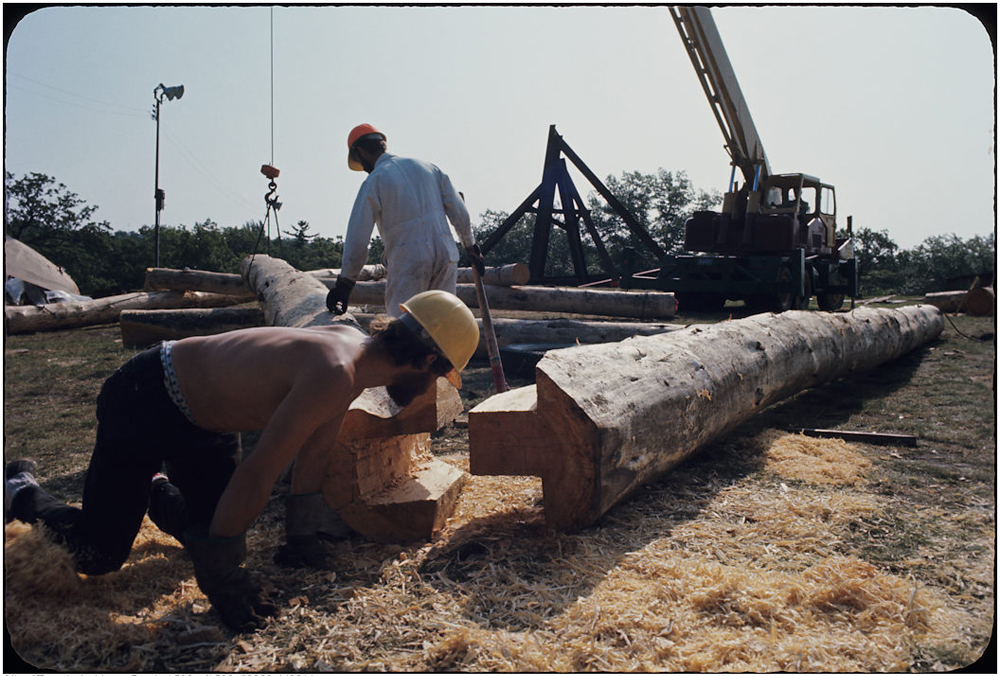 Mark di Suvero at work on No Shoes in High Park in 1967. Steel, cable and wood. Image from City of Toronto Archives, Fonds 1598, File 3, Item 11. Original Photograph by Arnaud Maggs.
Mark di Suvero at work on No Shoes in High Park in 1967. Steel, cable and wood. Image from City of Toronto Archives, Fonds 1598, File 3, Item 11. Original Photograph by Arnaud Maggs.
“Anything Was Possible”
David Mirvish speaks of that era’s aesthetic experimentation as one expression of a broader cultural idealism. “John Kennedy and Jacqueline changed the atmosphere… and they made us think anything was possible. And we had a prime minister that said: don’t work at a job you don’t like, work at something you want to do with your life. And we all thought anything was possible.”
For their part, artists were pushing literal, physical boundaries: stretching canvas into new shapes; working beyond gallery walls.
While many of the era’s avant gardes were American abstractionists, Mirvish contends that Canada kept pace. “We as a country actually played a game. We were in the game, at the top of the game.” Canada produced its own talent, but not in isolation: fostering international dialogue was a priority. As Altman explained to me from her office at the Bentway, the centennial in particular comprised “a real effort to announce ourselves to the world.”
Where the sesquicentennial has—at its best—been an opportunity to consider Canada’s own oft-forgotten histories and overlooked identities, the centennial was the celebration of a markedly more extroverted nation. And an extroverted city: “In ’67 there was a much more active effort to try to present Toronto as an international city, and to look to international artists and artists of significance like Moore,” reflected Altman.
Indeed, Henry Moore’s The Archer had been installed in front of Toronto’s City Hall less than a year before the symposium. Its lineage was different than the symposium sculptures, but it represented a similar kind of coup. Altman explains that “getting a Moore within a city almost was thought of as a city’s coming of age.”
Not everyone wanted Toronto to grow up, though. Public support flailed, and legislators rejected the proposal for the Moore. Mayor Phillip Givens persisted, ultimately funding the sculpture by soliciting private donations.
Despite not using public funds, the Moore installation hurt Givens’ reputation. Mirvish recalls the backlash: the mayor “lost the next election, because the public always thought: ‘Oh, here’s the mayor wasting money on this abstract sculpture.’”
And Givens’ loss was just one defeat amid a number of disillusionments; by Mirvish’s account, the optimistic boom was going bust as the 1970s approached. “A much more complicated world than we thought we had” was emerging, he recalls.
Materials like steel and bronze, though, are known to be stoic in the face of change.The Archer still stands where it was installed.
As for the Sculpture Symposium, Mirvish said that the work—Mark di Suvero’s in particular—stood like a “knife in time in a certain place,” marking a critical juncture, and signifying that “‘this was the best that we were, in that moment.’”
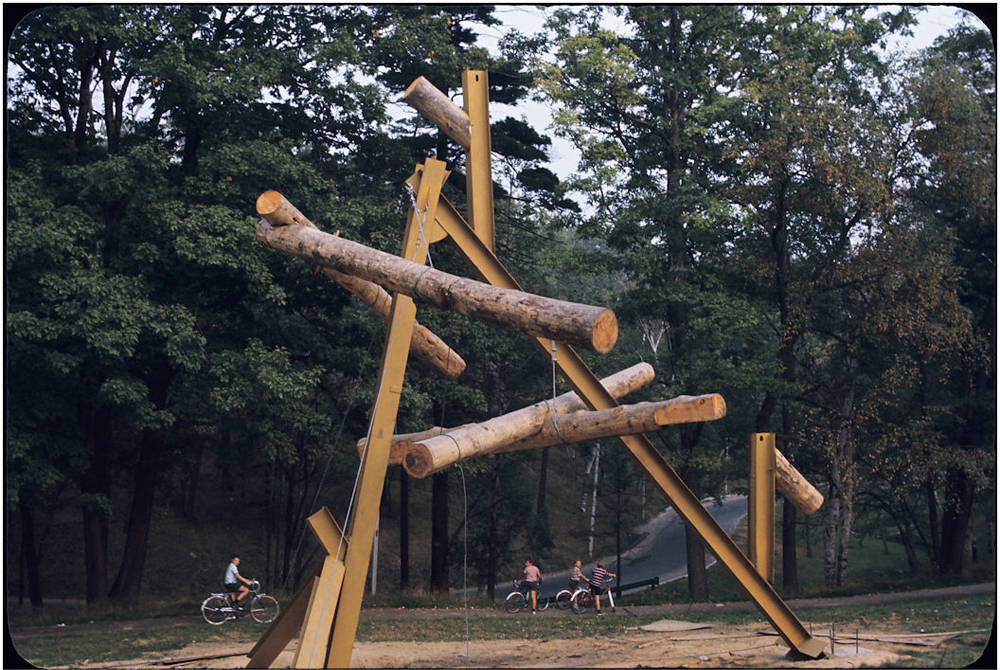 Mark di Suvero’s in-progress installation No Shoes in Toronto’s High Park in 1967. Steel, cable and wood. Image from City of Toronto Archives, Fonds 1598, File 3, Item 17. Original Photograph by Arnaud Maggs.
Mark di Suvero’s in-progress installation No Shoes in Toronto’s High Park in 1967. Steel, cable and wood. Image from City of Toronto Archives, Fonds 1598, File 3, Item 17. Original Photograph by Arnaud Maggs.
The Development of an Artist
Of the artists who participated in the High Park Sculpture Symposium, Mark di Suvero may now be the most acclaimed. The artist was 33 then, and near the beginning of an international career; his work has since graced many outdoor sites across the world. In 2011, Obama awarded him the National Medal of Arts; his cohort included Meryl Streep and Harper Lee.
Di Suvero’s signature sculptures are constellations of large steel beams, typically at least a storey high. The beams are often painted red (vermillion, oxblood) and they usually lean, welded or bolted to others, suspended and supported by thick metal cables. Diagonals create a strong sense of energy; often the heavy lines seem to be stretching, reaching. With their geometries and feats of suspension, the works are to bridges what dreams are to days: made of the same parts, with a less immediate purpose.
Though their meanings aren’t self-evident, di Suvero’s structures are inviting. Like many artists committed to working in the public realm, Di Suvero is an anti-elitist who values accessibility, and his work sometimes literalizes that ethic. A di Suvero sculpture in Michigan features a tire swing, for example. Another suspends an oil drum that viewers are invited to push; while installing it in 1985, di Suvero explained his intention “to make people feel their own capacity to move these masses.”
Where the design of a di Suvero is less overtly interactive, viewers sometimes climb the sculptures anyway. In the most newsworthy such incident, a Torontonian climbed to the top of a di Suvero work in New York’s Zuccotti Park during the Occupy protests in 2011. From its crest, he demanded a meeting with the mayor. He was denied, and taken to Bellevue for a psychological assessment; afterwards, the police surrounded the sculpture with barricades.
The two works di Suvero contributed to Toronto’s Sculpture Symposium were No Shoes, which incorporates several suspended logs, and Flower Power, which comprises a pair of pyramid shapes that encounter each other at their crests. There was rumoured to be a third, smaller sculpture too—perhaps small enough for the artist to haul back over the border in his pick-up truck with its all-caps “MAKE LOVE NOT WAR” slogan spray-painted across the bumper (di Suvero was active, and arrested, at several anti-Vietnam protests that decade).
If the symposium marked a turning point for Toronto, it also figured prominently in di Suvero’s development.
“Di Suvero cites the event as really being instrumental in helping him develop his signature style,” explained Altman, “because it was the first time he worked with a crane operator and really learned how to work with steel in an effective way.”
Art consultant Karen Mills, who has worked with di Suvero directly, agrees about the enormous impact of the crane, as does di Suvero’s studio director. Both note that the artist remembered the symposium fondly. “For him,” Mills explained over email, “this was a real landmark event and he treasured the experience.”
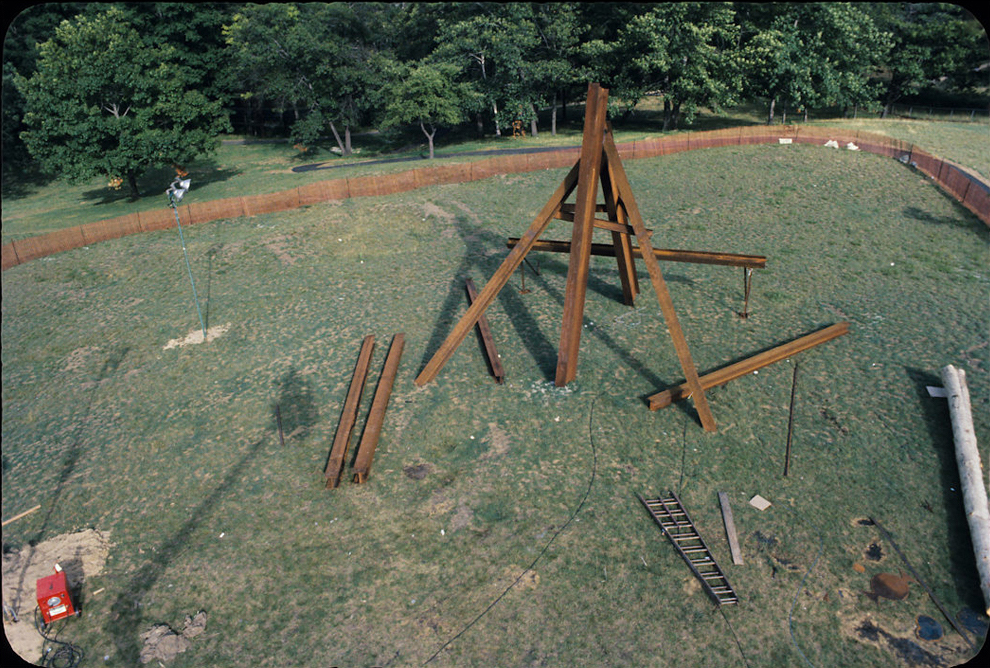 One of Mark di Suvero’s works under construction in High Park sin 1967. Image from City of Toronto Archives, Fonds 1598, File 3, Item 5. Original Photograph by Arnaud Maggs.
One of Mark di Suvero’s works under construction in High Park sin 1967. Image from City of Toronto Archives, Fonds 1598, File 3, Item 5. Original Photograph by Arnaud Maggs.
A Marked Untreasuring
Di Suvero’s treasuring of Toronto was not reciprocated by the city. At least, the city fell down on that unglamorous, administrative equivalent of treasuring that is preservation and maintenance.
Left untended in the park for decades, di Suvero’s sculptures rusted from lofty gifts into shameful blights. Early on, the parks department disassembled the works and left their component parts to lie indefinitely fallow in the grass.
Different sources give different reasons for this disassembly. According to one explanation, the parks department lacked liability insurance, and they worried about the hazards to kids who might be tempted to climb the sculptures. Alternatively, the sculptures may have been taken apart in response to cables snapping, or even having been cut.
In one way or other, it seems, the city’s facilitation of aesthetic riskiness morphed into a fear of physical danger. The “knife in time” that David Mirvish had admired proved too sharp for the dull city Toronto was known to be.
Altman calls the neglect of the di Suveros “an extreme example” of a disappointingly common, and still pervasive, flaw in Toronto: the inability “to build appreciation for what we have.”
Today, Mirvish notes how important the di Suveros in particular were, and how rare in an urban space: “There are not a bunch of cities that have this.” He laments that Toronto should have been much more grateful—or, at least, more brand savvy, since celebrating “coloured painted sculptures of the 1960s that can go outdoors, on this scale, is really a way to differentiate ourselves.”
Mirvish appreciates the works for their scale, their colour, the visceral experience they foster. He also notes how “the supporting cables give a certain tension to all of it,” something he couldn’t put his finger on—“not fragility,” exactly.
Indeed, the cables are extremely strong, and essential to the work’s structural integrity. But there’s something conspicuously modest about them: crucial though they may be, they’re not vivid or heroic, like the beams.
So whether or not it was a cable issue that downed the works initially, that theory has the ring of poetic accuracy. The cables are to the beams, perhaps, as maintenance is to creation: secondary and unglamourous, but a disaster to compromise.
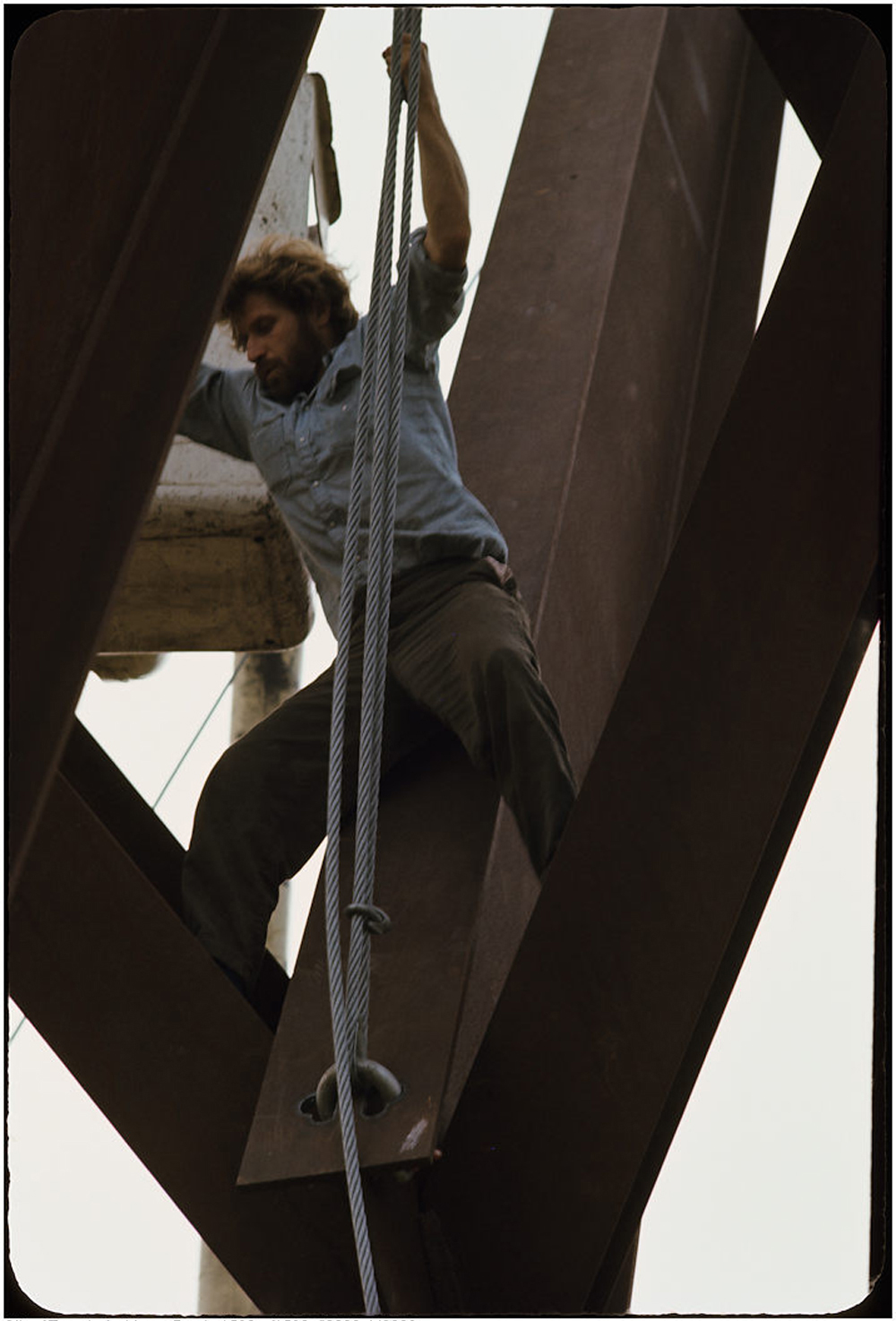 Mark di Suvero during the construction of No shoes in 1967. Steel, cable and wood. Image from City of Toronto Archives, Fonds 1598, File 3, Item 9. Original Photograph by Arnaud Maggs.
Mark di Suvero during the construction of No shoes in 1967. Steel, cable and wood. Image from City of Toronto Archives, Fonds 1598, File 3, Item 9. Original Photograph by Arnaud Maggs.
After the Revolution
Two years after the symposium, in 1969, Mierle Laderman Ukeles published a manifesto that emphasized entrenched differences between making an artwork and maintaining it. Creation (“development”) channeled what was new and progressive and exciting, while maintenance existed, in a supporting role, to “preserve the new; sustain the change; protect progress; defend and prolong the advance; renew the excitement.”
Renewing the excitement, though, is a tedious business.“Maintenance is a drag,” wrote Ukeles, and she emphasized the sociopolitical consequences: “The culture confers lousy status on maintenance jobs.” Typically, this labour is gendered, racialized and undervalued. And it wasn’t particularly considered during the pique of the symposium celebrations.
Technically, these works aren’t especially high maintenance: di Suvero’s studio director says that their upkeep primarily comprises repainting. But part of maintenance is also contingency planning, and such plans were entirely absent from the symposium.
“After the revolution,” asked Ukeles, “who’s going to pick up the garbage on Monday morning?” That a city is no one in particular is a problem when it inherits artworks: no one is de facto responsible.
And while there’s a clearer infrastructure now, in 1967 it wasn’t at all clear who should respond to the fragments of steel lying in the grass at High Park.
There had, though, been a vague instruction given at a wrap party by New York gallerist (and di Suvero’s dealer) Richard Bellamy to David Mirvish.
“I was standing on the balcony and he said, ‘David, you’re responsible for the sculptures of Mark’s.”” Mirvish admits that he had “no idea what that meant.” Bellamy and Mirvish were friends by then, and they continued their friendship long afterwards, but regarding the di Suveros, Mirvish says “I didn’t quite know what my job was or what I was to do.”
Ultimately, Mirvish emphasizes, he “never accepted” the stewardship offered him. But in the decades after the works’ disassembly, he did approach different politicians about restoring the sculptures. He also said that, knowing most politicians’ fear of a Givens-like fate, he “didn’t plea as hard” as he might have pled before an audience he trusted to care.
Mark di Suvero, No shoes, 1967. Steel, cable and wood. Image from City of Toronto Archives, Fonds 1598, File 3, Item 21 • Original Photograph by Arnaud Maggs.
(Re)making Amends
The situation finally found a sympathetic politician in Mayor David Miller. Miller launched the Clean City, Beautiful City initiative in 2005 and under this umbrella, art consultant Karen Mills committed to restoring the disrepaired di Suvero work.
The American sculptor was reticent about this revival, at first. Though he might have forgiven the initial gaffe, di Suvero had in the interim approached the City of Toronto with an offer to restore the works at his own expense. According to his studio director, the City had made the process so difficult he’d given up.
Mills, though, won him over: she had Mirvish introduce her; she explained her interest was as a private citizen; she mentioned that she came from a lineage of builders. And the City, ultimately, funded the restoration.
Di Suvero repaired the beams for No Shoes and Flower Power in his studio in Long Island City, New York. The wood that hangs in No Shoes was replaced locally. Di Suvero then helped a crew re-erect the two works at two separate, new Toronto sites.
By all accounts, the artist was pleased with the new locations and, indeed, happy to have the work stand again. No Shoes now presides over Corktown Commons, and Flower Power overlooks railway tracks from CityPlace condo complex. Ironically, these works initially heralded for the novelty of their site-specificity could only survive by displacement.
The Meanings of Moving
The ways that legacy is bound up with public art in general—and monuments in particular—has become pressing as American cities reckon with fresh urgency about the Confederate statues in their midsts. Most of the monuments in question are at least several decades old, but change has accelerated recently, in the wake of the August 2017 events in Charlottesville.
New Orleans had Confederate statues removed a few months before Charlottesville. The mayor of New Orleans, Mitch Landrieu, was careful to emphasize then that the removal did not represent an intention to forget, but rather a commitment to remember fully. Which is to say: without glorifying (the figures, he noted, literally stood on pedestals), and unselectively (he noted the absence of public works memorializing slaveships or lynchings).
Landrieu also emphasized the limits of the gestures: “History cannot be changed. It cannot be moved like a statue.” Moving the statues was nevertheless crucial: they were built explicitly as reminders of a racist cause, and sheer force of interpretation couldn’t recontextualize them as cautionary tales. As much as a sculpture, like a word, might change its meaning over time, there’s a limit to how much context can change a work.
In Toronto, City Hall has been reviewing a proposal to move The Archer so that a large sculpted turtle, commemorating the victims of residential schools, might take its place. Globe and Mail columnist Marcus Gee objects to the proposed relocation of The Archer. Letters to the editor all agreed with him about leaving The Archer where it is; one letter equated its relocation with vandalism. Gee described the sculpture as a testament to “that shining moment when the city… embrace[d] the future.” He quoted an architect who felt “it doesn’t seem appropriate that we should be erasing an important piece of culture in order to commemorate Indigenous erasure.”
But is moving a sculpture really, or always, erasure? In New Orleans, moving statues was a way to condemn their message (though some have been demolished, some are destined for institutions, where they can be properly contextualized).
In di Suvero’s far less politicized case in Toronto, the relocation had the opposite motivation: it was a rescue mission, a refusal to write off the meaning of an important moment. Though critics like Gee equate relocation with defeat, that conclusion is not foregone.
As far as The Archer is concerned, there’s something strange about fighting to keep a sculpture static even while celebrating it a symbol of risk taken, progress won. Perhaps Flower Power and No Shoes, as site-specific works, present a limit case of sorts; perhaps a case that models a way forward.
The neglect of Mark di Suvero’s sculptures in Toronto always will have happened, and this is worth confronting. Ultimately, though, di Suvero’s works survived their forgetting, and remembrance, and transplanting. If without much fanfare, their revival transpired with a lot of effort, and not a little grief. But afterwards, the works turned out to be something between fleeting and eternal: they proved adaptable.
Heather White is a writer and a therapist in Toronto.

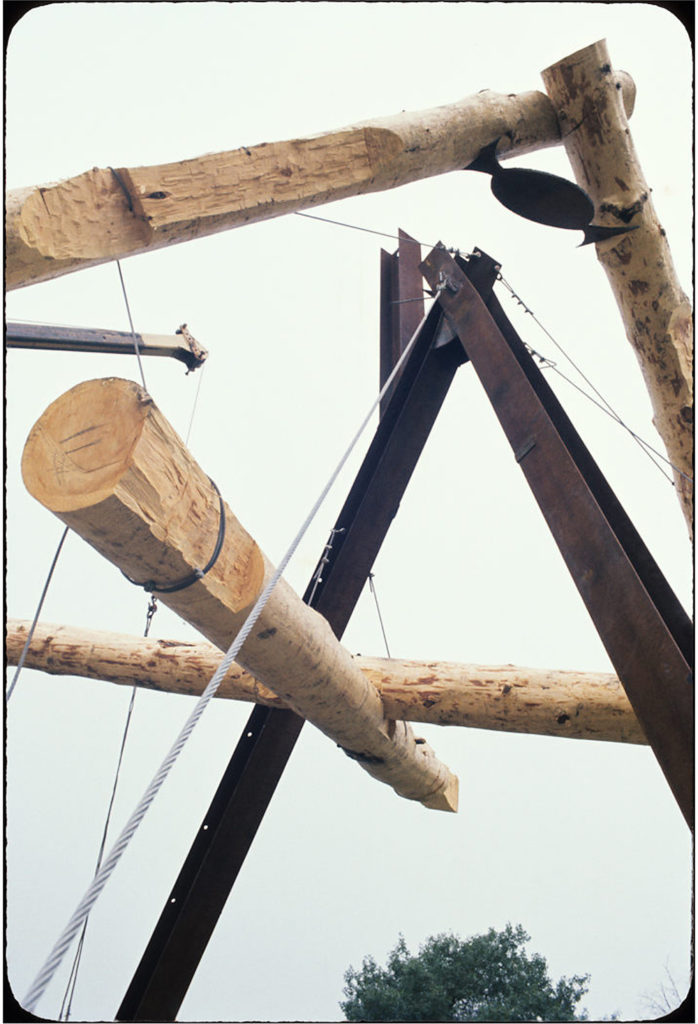 Mark di Suvero's No shoes under construction in 1967. Steel, cable and wood. Image from City of Toronto Archives, Fonds 1598, File 3, Item 14 • Original Photograph by Arnaud Maggs.
Mark di Suvero's No shoes under construction in 1967. Steel, cable and wood. Image from City of Toronto Archives, Fonds 1598, File 3, Item 14 • Original Photograph by Arnaud Maggs.
